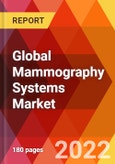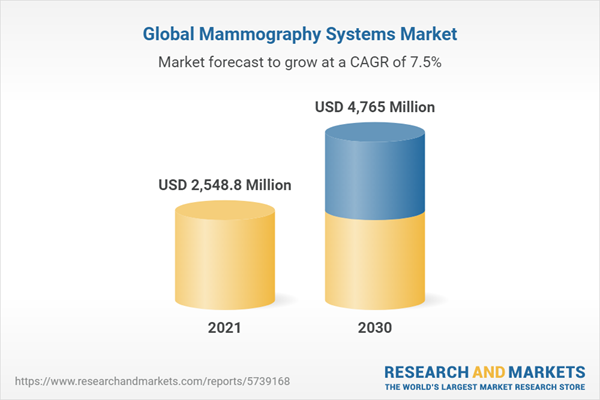The global mammography systems market held a market value of USD 2,548.8 million in 2021 and is projected to reach USD 4,765.0 million by the year 2030. The market is projected to list a CAGR of 7.5% during the forecast period.Global Mammography Systems Market is projected to grow at a CAGR of 7.5% during the forecast period 2022-2030
One of the main reasons projected to propel demand for mammography systems throughout the forecast period is the rising prevalence of breast cancer and the rising demand among patients for early-stage diagnosis. Some of the key elements anticipated to fuel the industry's growth include expanding government initiatives to promote clinical interpretation and greater accessibility to breast cancer screening systems.
The COVID-19 pandemic significantly impacted breast imaging procedures. Lockdowns and other limitations imposed by governments throughout the world have impacted market demand. Governments have put rules in place that delay elective and non-urgent medical operations in order to stop the virus from spreading. Additionally, the virus's fear of transmission, notably during COVID-19's initial wave in 2020, led to a large decline in breast imaging findings. According to data from Breast Cancer Now (UK) from September 2020, COVID-19 caused over 9,86,000 women in the UK to skip their breast screening appointments. According to a study published in the Eurasian Journal of Medical Investigation in 2020, mammography in Turkey decreased by 64% when compared to data from 2019.
As a result, the risk of radiation exposure rising will provide new difficulties for the breast imaging. On the other hand, the high price of imaging equipment or technologies would impede the market's growth. Due to the unfavourable reimbursement scenario in emerging and undeveloped countries, the market will also face considerable challenges. However, the COVID-19 outbreak's introduction of unfavourable conditions and strict regulatory approval procedures impede market expansion.
Growth Influencers:
Growing prevalence of breast cancer
One of the main variables influencing the market for mammography systems is the increasing prevalence of breast cancer. The American Cancer Society estimates that in 2020, there will be around 276,480 new cases of invasive breast cancer in women. In addition, it has been determined that 48,530 women have in situ breast cancer, and it is anticipated that this figure will increase in the upcoming years. Additionally, a lot of businesses have started to launch efforts to support breast cancer screenings. Moreover, according to the Centers for Disease Control and Prevention, regardless of race or ethnicity, breast cancer is the most common malignancy in most Asian countries (CDC). The age-standardized incidence rate of breast cancer in Asia is 34.4 per 100,000 individuals, according to GLOBOCAN 2018. Thus, the rising incidence of breast cancer is anticipated to support overall growth.Technological advancements in the field of breast imaging
Collaborations between the public and private sectors generate a wave of awareness that accelerates the market for mammography equipment. Densitas Inc., a global supplier of A.I. solutions for digital mammography and breast screening, released the first artificial intelligence-powered telehealth technician training platform in November 2020 in collaboration with Mammography Educators. This platform will support the ongoing operations of mammography facilities. In collaboration with Mammography Educators, Densitas is offering specialised educational materials and a telemedicine solution that offers real-time virtual training based on Densitas IntelliMammo technician assessments. The densitas intelliMammo suite provides quantitative picture quality measures at the technician and mammography facility levels, enabling the detection of trends in technicians' productivity. This makes it possible for mammography educators to create a mammography-specific, evidence-based curriculum.Segments Overview:
The global mammography systems market is segmented into product type, modality, and end user.By Product Type
Analog Mammography Systems
Digital Mammography Systems
The analog mammography systems segment held the highest market share of more than 60% in 2021.By Modality
Portable Mammography Systems
Non-Portable Mammography Systems
The portable mammography systems is projected to hold the highest market share with largest CAGR of 7.8% over the forecast period.By End User
Impatient Settings
Ambulatory Surgical Center
The inpatient settings segment is expected to reach USD 3,345.8 million by 2030.ssRegional Overview
The global mammography systems market is expected to grow generously during the forecast period due to the rising strategic expansions. The market based on region, is segmented into North America, Europe, Asia Pacific, Middle East and Africa, and South America. The Asia Pacific market for mammography systems held the largest market share of more than 30%. The North American market for mammography systems is projected to grow at a highest growth rate of 8.2% over the forecast period.Competitive Landscape
The prominent players operating in the global mammography systems market include Allengers Medical Systems Limited, Fujifilm Holding Corporation, General Electric Company, Hologic Incorporated, Toshiba Corporation, Konica Milota Incorporated, Koninklijke Philips N.V. (Philips Healthcare), Metaltronica SPA, Planmeca OY, Siemens Aktiengesellschaft, and others. The major players in the market hold approximately 50% of the total market share. These market players are capitalizing in product launches, joint ventures, expansions, mergers. Siemens Aktiengesellschaft generated 48% of its revenue from Europe, CIS, Africa, Middle East regions, whereas it generated 28% through Americas region.The global mammography systems market report provides insights on the below pointers:
Market Penetration: Provides comprehensive information on the market offered by the prominent playersMarket Development: The report offers detailed information about lucrative emerging markets and analyzes penetration across mature segments of the markets
Market Diversification: Provides in-depth information about recent developments, and investments
Competitive Landscape Assessment: Mergers & acquisitions, certifications, product launches in the global mammography systems market have been provided in this research report. In addition, the report also emphasizes the SWOT analysis of the leading players
Product Development & Innovation: The report provides intelligent insights on future technologies, R&D activities, and breakthrough product developments
Pricing Analysis: Pricing analysis of various components used in the manufacturing of mammography systems
Manufacturing Cost Analysis: Cost-share of various components, cost analysis, unit cost analysis
Demographic analysis under mammography
The global mammography systems market report answers questions such as:
What is the market size and forecast of the global mammography systems market?What are the inhibiting factors and impact of covid-19 on the global mammography systems market during the assessment period?
Which are the types/segments/applications/areas to invest in over the assessment period in the global mammography systems market?
What is the competitive strategic window for opportunities in the global mammography systems market?
What are the technology trends and regulatory frameworks in the global mammography systems market?
What is the market share of the leading players in the global mammography systems market?
What modes and strategic moves are considered favorable for entering the global mammography systems market?
Table of Contents
Chapter 1. Research Framework1.1 Research Objective
1.2 Product Overview
1.3 Market Segmentation
Chapter 2. Research Methodology
2.1 Qualitative Research
2.1.1 Primary & Secondary Sources
2.2 Quantitative Research
2.2.1 Primary & Secondary Sources
2.3 Breakdown of Primary Research Respondents, By Region
2.4 Assumption for the Study
2.5 Market Size Estimation
2.6. Data Triangulation
Chapter 3. Executive Summary: Global Mammography Systems Market
Chapter 4. Global Mammography Systems Market Overview
4.1. Industry Value Chain Analysis
4.1.1. Material Provider
4.1.2. Manufacturers
4.1.3. Distributor
4.1.4. End user
4.2. Industry Outlook
4.2.1. Overview of Mammography Systems Market
4.2.2. Demographic analysis under Mammography
4.3. Porter's Five Forces Analysis
4.3.1. Bargaining Power of Suppliers
4.3.2. Bargaining Power of Buyers
4.3.3. Threat of Substitutes
4.3.4. Threat of New Entrants
4.3.5. Degree of Competition
4.4. Market Dynamics and Trends
4.4.1. Growth Drivers
4.4.2. Restraints
4.4.3. Challenges
4.4.4. Key Trends
4.5. Covid-19 Impact Assessment on Market Growth Trend
4.6. Market Growth and Outlook
4.6.1. Market Revenue Estimates and Forecast (US$ Mn), 2017 - 2030
4.6.3. Price Trend Analysis
4.7. Competition Dashboard
4.7.1. Market Concentration Rate
4.7.2. Company Market Share Analysis (Value %), 2021
4.7.3. Competitor Mapping
4.7.4. Promotional Marketing Strategies and USPs
Chapter 5. Global Mammography Systems Market Analysis, By Product Type
5.1. Key Insights
5.2. Market Size and Forecast, 2017 - 2030 (US$ Mn)
5.2.1. Analog Mammography Systems
5.2.2. Digital Mammography Systems
Chapter 6. Global Mammography Systems Market Analysis, By Modality
6.1. Key Insights
6.2. Market Size and Forecast, 2017 - 2030 (US$ Mn)
6.2.1. Portable Mammography Systems
6.2.2. Non-Portable Mammography Systems
Chapter 7. Global Mammography Systems Market Analysis, By End User
7.1. Key Insights
7.2. Market Size and Forecast, 2017 - 2030 (US$ Mn)
7.2.1. Impatient Settings
7.2.2. Ambulatory Surgical Centers
Chapter 8. Global Mammography Systems Market Analysis, By Region
8.1. Key Insights
8.2. Market Size and Forecast, 2017 - 2030 (US$ Mn)
8.2.1. North America
8.2.1.1. The U.S.
8.2.1.2. Canada
8.2.1.3. Mexico
8.2.2. Europe
8.2.2.1. Western Europe
8.2.2.1.1. The UK
8.2.2.1.2. Germany
8.2.2.1.3. France
8.2.2.1.4. Italy
8.2.2.1.5. Spain
8.2.2.1.6. Rest of Western Europe
8.2.2.2. Eastern Europe
8.2.2.2.1. Poland
8.2.2.2.2. Russia
8.2.2.2.3. Rest of Eastern Europe
8.2.3. Asia Pacific
8.2.3.1. China
8.2.3.2. India
8.2.3.3. Japan
8.2.3.4. South Korea
8.2.3.5. Australia & New Zealand
8.2.3.6. ASEAN
8.2.3.7. Rest of Asia Pacific
8.2.4. Middle East & Africa
8.2.4.1. UAE
8.2.4.2. Saudi Arabia
8.2.4.3. South Africa
8.2.4.4. Rest of MEA
8.2.5. South America
8.2.5.1. Argentina
8.2.5.2. Brazil
8.2.5.3. Rest of South America
Chapter 9. North America Mammography Systems Market Analysis
9.1. Key Insights
9.2. Market Size and Forecast, 2017 - 2030 (US$ Mn)
9.2.1. By Product Type
9.2.2. By Modality
9.2.3. By End User
9.2.4. By Country
Chapter 10. Europe Mammography Systems Market Analysis
10.1. Key Insights
10.2. Market Size and Forecast, 2017 - 2030 (US$ Mn)
10.2.1. By Product Type
10.2.2. By Modality
10.2.3. By End User
10.2.4. By Country
Chapter 11. Asia Pacific Mammography Systems Market Analysis
11.1. Key Insights
11.2. Market Size and Forecast, 2017 - 2030 (US$ Mn)
11.2.1. By Product Type
11.2.2. By Modality
11.2.3. By End User
11.2.4. By Country
Chapter 12. Middle East and Africa Mammography Systems Market Analysis
12.1. Key Insights
12.2. Market Size and Forecast, 2017 - 2030 (US$ Mn)
12.2.1. By Product Type
12.2.2. By Modality
12.2.3. By End User
12.2.4. By Country
Chapter 13. South America Mammography Systems Market Analysis
13.1. Key Insights
13.2. Market Size and Forecast, 2017 - 2030 (US$ Mn)
13.2.1. By Product Type
13.2.2. By Modality
13.2.3. By End User
13.2.4. By Country
Chapter 14. Company Profile (Company Overview, Financial Matrix, Key Product landscape, Key Personnel, Key Competitors, Contact Address, and Business Strategy Outlook)
14.1. Allengers Medical Systems Limited
14.2. Fujifilm Holding Corporation
14.3. General Electric Company
14.4. Hologic Incorporated
14.5. Konica Milota Incorporated
14.6. Koninklijke Philips N.V. (Philips Healthcare)
14.7. Metaltronica SPA
14.8. Planmeca OY
14.9. Siemens Aktiengesellschaft
14.10. Toshiba Corporation
14.11. Other Prominent Players
Executive Summary
Due to the rising incidence and prevalence of breast cancer, the global market for mammography systems is anticipated to expand steadily. Digital mammography system technology developments have a significant impact on the market's expansion. The expensive price of the product, the possibility of radiation-related ill events, and the onerous reimbursement procedures, however, reduce the preference rates. By 2030, it is expected that the sector will generate USD 4,765.0 million. In addition, the major market players take part in strategic endeavours including acquisitions and product launches. Based on product type, modality, and end user, the market is divided into segments.Companies Mentioned (Partial List)
A selection of companies mentioned in this report includes, but is not limited to:
- Allengers Medical Systems Limited
- Fujifilm Holding Corporation
- General Electric Company
- Hologic Incorporated
- Toshiba Corporation
- Konica Milota Incorporated
- Koninklijke Philips N.V. (Philips Healthcare)
- Metaltronica SPA
- Planmeca OY
- Siemens Aktiengesellschaft
Table Information
| Report Attribute | Details |
|---|---|
| No. of Pages | 180 |
| Published | December 2022 |
| Forecast Period | 2021 - 2030 |
| Estimated Market Value ( USD | $ 2548.8 Million |
| Forecasted Market Value ( USD | $ 4765 Million |
| Compound Annual Growth Rate | 7.5% |
| Regions Covered | Global |









